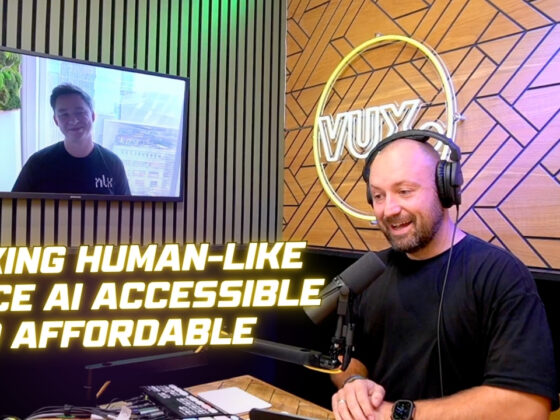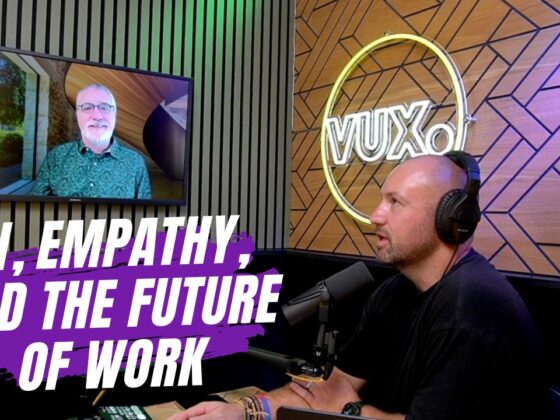Generative AI and the rise of voice interfaces could turn brand identity on its head. What was once a fixed, one-size-fits-all brand image could become an ultra-personalised, adaptive experience. A brand that sounds different to everyone, yet remains recognisably itself.
To demonstrate the impact that generative voice AI could have on brand identity, and thus loyalty, we should look at what brand identity is, then how voice AI in customer experience could impact it and, finally, what that means for your AI strategy, and the proposed outcomes it could help you achieve.
The ‘old’ Brand Identity model

Kapferer’s visualised brand identity prism: six facets reflecting how a brand expresses itself and how audiences perceive it: physique, personality, culture, relationship, reflection and self-image.
The Brand Identity Prism, published in 1992 by Jean-Noël Kapferer in his book Strategic Brand Management: New Approaches to Creating and Evaluating Brand Equity, has become the go-to framework used to create the identity of some of the world’s most loved brands. A brand identity is what enables those brands to differentiate themselves from competitors by creating, in the mind of the ‘receiver’ (prospect or customer) a perceptively unique mental image.
How Brand Identity has historically manifested in voice AI
The concept of personality, or persona, has long been a concern for conversational AI practitioners, too. Building on Clifford Nass and Scott Brave’s work in Wired for Speech, conversation designers know that a voice itself carries social meaning: tone, pitch, pacing and gender, all of which, when heard, trigger automatic assumptions about personality, intelligence and trustworthiness. I’ve had conversations about this very topic, and its implications for applied AI practitioners going back as far as 2019.
With voice AI, the sound of the voice is all you have. The voice is the interface, so shaping that voice is crucial.
In How Brands Grow, Byron Sharpe showed that brands grow through:
- wide availability (penetration),
- mental and physical availability (being remembered), and
- distinctiveness (standing out).
It’s the latter that’s been the concern for conversational AI designers in both voice and text modalities. How do you shape a brand persona that’s distinct, stands out and turns your voice interface into a loyalty-driver?
The limitations of brand personality in voice AI to date
Turns out that, even though AI designers over the years have been switched-on to the importance of AI personalities, the tools with which to design them have been limited.
You’ve always been confined to the basics, as summarised by Rebecca Evanhoe and Diana Diebel in Conversations with Things:
- tone,
- personification (how human-like the system is),
- power dynamics (how it acts when it has the power to say no),
- key behaviours (i.e. how it handles objections or things it doesn’t understand)
- traits (i.e. key personality factors that matter in the interaction)
All of these are aligned to the overarching goal of the assistant or the interaction.
Mapping out those things are absolutely required in today’s AI landscape still, but what we do today could easily evolve past this static representation into a dynamically shifting suite of traits quite quickly.
Static personas don’t create personal experiences
See, this concept of persona design in AI falls prey to the same limitations as Kapferer’s Brand Identity Prism. That is, they’re rigid. Kapferer’s model was born in an era of broadcast communication. It’s a one-size-fits-all model. You create it once and, from then-on, every customer gets the exact same treatment or experience. The same is true of historic efforts in AI persona design.
Voice AI now introduces a feedback loop, turning what was once a fixed prism into a living system that could adapt in real time to every individual interaction. The same applies to the concept of distinctiveness. It has always been treated as a fixed brand asset; a single voice, colour, logo or tone.
Take Amazon Alexa, for example. Amazon worked extremely hard on Alexa’s persona. Google, too, on Google Assistant. They created persona templates, tone of voice guides, entire backstories, custom voices, the whole 9 yards. All so that each one of the millions of users could have the exact same experience. A static, one-dimensional experience that can’t adapt to the tone of the user. One that gives the illusion of humanness without the one thing that makes it truly human: responsiveness.
Providing your customers with the exact same experience works fine if you’re, say, building an app. In an app, every customer journey will be the same. You can define the experience using the constraints of a screen and mandate that every customer take the same journey.
This rigidity made sense in an era of mass communication, when consistency equaled strength. But in an era of generative voice interfaces, where no two interactions are ever the same, identity must evolve from something you broadcast into something you orchestrate.
From static identity to dynamic brand DNA
In a conversation, every single customer speaks differently. Every single conversation your AI agent has is likely to be completely different from the last (at least from the perspective of the language used). And the language used will in some ways be influenced by the personality of your user. Couple that with the rich data landscape available to us and we have the foundations for some truly scalable brand personality nuances. Brand personality that adapts to the user in real time.
With advancements in generative and voice AI, you could start to view brand identity like a living organism. One that flexes, listens and responds to the person on the other side of the conversation.
If Kapferer’s original Brand Identity Prism was a snapshot of who the brand is, then voice AI turns that snapshot into a feedback loop.
How voice AI advancements could impact Brand Identity as we know it
Imagine a human call centre agent answering calls all day. They’ll speak to all kinds of different people. People with differing demographics, psychographics, emotions and needs. The person answering the call has to adapt to the situation they’re in, and to the person they’re talking with. They have to use their initiative to solve the problem within the boundaries of what the brand enables them to do.
Do you care about the specific language used? Do you care about the sound of their voice? Or do you care more about them responding to the specific needs and behaviour of the person they’re speaking with?
Companies like Behavioral Signals have proven that great conversations are influenced by conversational styles. As is, those that share the same conversational style have higher quality conversations.
So how can voice AI give rise to the same kind of personalisation? The same one-to-one adaptability that your people bring? How can voice AI provide a better than human, scalable personalised experience?
Physique becomes the adaptive interface
The voice, tone and rhythm of the conversation could shift to meet the listener’s context. This is the first level of personalisation. For example:
- Demographic-level tuning: slowing down the voice for older users, a technique proven to have a positive impact on usability.
- Inflection and prosody control (intonation, emphasis) to match the emotional weight of the message, such as some early examples we’ve seen from the likes of Seseme.
- Language capabilities: adapting to the language of the user and code switching in multi-lingual use cases.
Physique, then, is how the brand sounds and feels physically. Its sensory presence. With voice AI, we have the beginnings of the tools to adapt this dynamically.
Personality becomes parametric expression
In the same way as you have an underlying character that changes dependent on the person you’re talking to, so too could your voice AI.
For example, you talk and act differently when you’re with your spouse than you do with your colleagues. And different still around your parents. And again different when meeting someone for the first time. Same underlying character, expressed through different variations.
The same too could be the case for voice AI:
- Response style preferences: direct vs narrative, concise vs descriptive.
- Emotion tags and markers: [sad], [calm], [excited] to tune emotional expression while staying “in character.”
- Adaptive tone control: personality flexing between warmth, authority, humour or empathy, depending on the user.
- Persona mirroring: aligning communication style to the user’s personality type (e.g., Myers–Briggs or behavioural archetype).
- Segment-specific voice variants (professional for finance, playful for retail, calm for healthcare).
The brand’s human-like character becomes multi-dimensional: consistent in values, variable in delivery.
Culture becomes The Governor
Brand culture becomes the moral compass, encoded into every output. For example:
- Ethical and tone guardrails: e.g., a healthcare assistant must remain compassionate and truthful even when tone adapts.
- Brand value enforcement: maintaining professionalism or empathy regardless of user emotion.
- Governance rules: “never use humour when delivering bad news”; “always reassure before redirecting.”
Culture defines how far AI can flex. It’s the invisible operating system that keeps every personalised interaction “on brand.” This is essentially guardrails. Encoded behavioural limits that ensure adaptability doesn’t break trust or compliance.
Relationship becomes a fluid interaction
All relationships change over time. Think about any friend you have. Your relationship with your friends is different now than it was 5 years ago. The more you get to know each other, the more the nature of your relationship changes.
Voice AI could play teacher, peer, helper or friend, depending on what the user needs in that moment, and perhaps even changing over time as it gets to know individual users more. For example:
- Dynamic role-switching: shifting from advisor to listener based on user state.
- Turn-taking adjustments: more proactive with uncertain users, more responsive with confident ones.
- Adaptive power dynamics: knowing when to lead vs. when to follow.
- Context-specific rapport: casual tone in gaming vs. formal tone in banking. Even specific use cases might determine this based on the level of risk involved.
- Empathetic pacing: matching user tempo to reduce frustration or anxiety.
The relational stance of the brand is no longer fixed; it changes in real time, but always within the same relationship ethos.
Reflection becomes a personal mirror
In behavioural psychology, mirroring (or the Chameleon Effect), involves naturally mimicking the behaviours of those you interact with (e.g., crossing arms, smiling, adjusting posture). First defined in modern psychology by Chartrand & Bargh (1999) in The Chameleon Effect: The Perception–Behavior Link and Social Interaction, it was found that mirroring increases likability and rapport.
With voice AI, there’s the potential for this level of personalisation, where each user could see a version of themselves mirrored back through tone, pacing and empathy. Not in an obvious, creepy way, but in ways such as:
- Emotional mirroring: calming an agitated user, amplifying enthusiasm for an excited one.
- Linguistic reflection: adopting similar phrasing or rhythm to create rapport similar to the Behavioral Signals example referenced earlier..
- Sentiment analysis-driven tone (matching the user’s energy or mood).
- Adaptive pacing: slowing down for reflective users, speeding up for action-oriented ones.
- Recognition of cultural or linguistic nuance (e.g., idioms, politeness norms).
- Pacing and disfluencies: if someone is ‘Uhm’ing and ‘Ah’ing a lot, subtly mirroring speech patterns that match their conversational style, a technique proven to lead to better conversations.
Here, the brand acts as a subtle mirror. Users see a reflection of themselves in the way it speaks, making each exchange feel deeply personal.
Self-image becomes interactive identity
A little bit like how you might think about ChatGPT today if you’re a power user. You habitually reach for it and feel like you can’t write an email without it. Imagine your brand has such a draw to customers that they feel like your AI service is central to their relationship with the brand because it enables them to be more aligned to their sense of self. That’s where we’re headed. Users feel seen, understood and even improved through the interaction.
For example:
- Adaptive affirmation: tone and phrasing that validate or empower users.
- Contextual memory use: remembering past interactions to create continuity and recognition.
- Assistants that support self-perception: e.g., sounding more professional during a work call, or more relaxed in leisure contexts.
- Long-term behavioural learning: the system evolves as the user grows or changes preferences.
- AI reflecting desired states: calmness, confidence, reassurance reinforcing the user’s best self.
The brand helps users feel aligned with their own identity, it becomes part of their sense of self through repeated, empathetic interaction.
Ethical considerations
Of course, with new capability comes new responsibility. The same power that allows dynamic empathy also opens uncomfortable ethical questions.
Is it right to use someone’s age field in your CRM to make assumptions about their mental faculties and decide to slow down the voice with the intention of making it easier to understand?
Is it right to use accent softeners on the input or output to make either user queries easier for ASR to transcribe or easier for users with accents to understand responses?
Is it right to make assumptions about someone’s education level based on the language used in conversation and thus mirror the same kind of language back to them in your responses? What about the inverse? Assuming someone’s less educated and ‘dumbing down’ your responses?
What about swapping the accent of the voice of the AI agent to marry the accent of the caller? Or swapping the gender to the opposite gender of the caller in an effort to fabricate a flirtatious persona to influence the conversation?
There are many considerations for how this kind of personalisation could be used. One of the questions you must ask yourself, as you’re exploring this topic, aside from ‘will it improve the customer experience?’ And ‘will it help us achieve our outcomes?’, is, crucially, ‘would the caller be happy if they knew we were doing this?’
The future brand is alive
Kapferer taught us that brand identity is the synthesis of what a brand is and how it’s perceived. Voice AI now turns that synthesis into a real-time exchange; a dialogue that continually refines itself through every interaction. The next decade will belong to brands that master this dance between coherence and personalisation; between fixed DNA and fluid expression.
When every customer hears a version of your brand that feels made just for them, something remarkable happens. Brand identity stops being a marketing construct and starts becoming a unique experience.
This article was inspired by a deep conversation with Andrei Papancea, NLX, and Kylan Gibbs, InWorld, on the VUX World Podcast recently.






